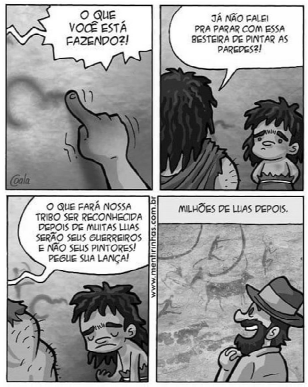Questões de Concurso
Para vestibular
Foram encontradas 1.411 questões
Resolva questões gratuitamente!
Junte-se a mais de 4 milhões de concurseiros!
Leia o excerto poético e observe a imagem para responder à questão.
Eu, Marília, não sou algum vaqueiro,
Que viva de guardar alheio gado,
De tosco trato, e dos sóis queimado.
Tenho próprio casal e nele assisto;
Dá-me vinho, legume, fruta, azeite;
Das brancas ovelhinhas tiro o leite,
E mais as finas lãs, de que me visto.
Graças, Marília bela
Graças à minha estrela.
GONZAGA, Tomás Antônio. Lira I. In: A poesia dos inconfidentes. Rio de Janeiro: Nova Aguilar, 1996. p. 7

Leia o excerto poético e observe a imagem para responder à questão.
Eu, Marília, não sou algum vaqueiro,
Que viva de guardar alheio gado,
De tosco trato, e dos sóis queimado.
Tenho próprio casal e nele assisto;
Dá-me vinho, legume, fruta, azeite;
Das brancas ovelhinhas tiro o leite,
E mais as finas lãs, de que me visto.
Graças, Marília bela
Graças à minha estrela.
GONZAGA, Tomás Antônio. Lira I. In: A poesia dos inconfidentes. Rio de Janeiro: Nova Aguilar, 1996. p. 7

Leia o texto a seguir para responder à questão.



MACHADO, Adilvênia Freire. Filosofia Africana e Saberes Ancestrais Femininos: útero do mundo. Disponível em: https://diplomatique.org.br/filosofiaafricana-e-saberes-ancestrais-femininos-utero-do-mundo/
Acesso em: 06 nov. 2020. (Adaptado).
Leia o texto a seguir para responder à questão.



MACHADO, Adilvênia Freire. Filosofia Africana e Saberes Ancestrais Femininos: útero do mundo. Disponível em: https://diplomatique.org.br/filosofiaafricana-e-saberes-ancestrais-femininos-utero-do-mundo/
Acesso em: 06 nov. 2020. (Adaptado).
Isso é indicado pelas seguintes oposições:
Leia o texto a seguir para responder à questão.



MACHADO, Adilvênia Freire. Filosofia Africana e Saberes Ancestrais Femininos: útero do mundo. Disponível em: https://diplomatique.org.br/filosofiaafricana-e-saberes-ancestrais-femininos-utero-do-mundo/
Acesso em: 06 nov. 2020. (Adaptado).
Leia o texto a seguir para responder à questão.



MACHADO, Adilvênia Freire. Filosofia Africana e Saberes Ancestrais Femininos: útero do mundo. Disponível em: https://diplomatique.org.br/filosofiaafricana-e-saberes-ancestrais-femininos-utero-do-mundo/
Acesso em: 06 nov. 2020. (Adaptado).
Leia o texto a seguir para responder à questão.



MACHADO, Adilvênia Freire. Filosofia Africana e Saberes Ancestrais Femininos: útero do mundo. Disponível em: https://diplomatique.org.br/filosofiaafricana-e-saberes-ancestrais-femininos-utero-do-mundo/
Acesso em: 06 nov. 2020. (Adaptado).
Observe o infográfico a seguir para responder à questão


According the information expressed in the image and data, 7 Benefits of Mobile Learning, we verify that
mLearning
Considere o excerto a seguir.
“Nos meados de seiscentos, a situação econômica portuguesa era de grade depressão. Numa consulta do Conselho da Fazenda, de 1657, descrevia-se a situação em traços sombrios: "A índia (...) acha-se hoje reduzida miseravelmente a seis praças principais que são: Moçambique, sem defesa; Goa, pouco segura; Diu, arriscada; Cochin, pendente da amizade do rei; Columbo, invadida pelos holandeses; Macau, sem comércio, desesperada (...) Angola, nervo das fábricas. A atividade do Brasil, necessita de prevenção contra os desejos que os castelhanos, ingleses e holandeses tem de nos tirarem os negros e os levarem às índias, às Barbadas e outras partes. A ilha de S. Tomé, onde se juntava o dinheiro de panos para engrossar o trato de Angola, se pôs em termos que já não parecem desta coroa, pois com ela não temos comércio nenhum.”
Disponível em:<www.humanas.ufpr.br/portal/cedope/files/2011/12/O
s-embates-políticos-e-ideológicos-no-reino-lusitanoda-Restauração-à-Viradeira-Algumas-consideraçõesJosé-Elias-Lara.pdf>
O documento evidencia a situação econômica de
Portugal em 1657, que se relaciona diretamente
com:
Considere o fragmento a seguir.
“Art. 26-A. Nos estabelecimentos de ensino fundamental e de ensino médio, públicos e privados, torna-se obrigatório o estudo da história e cultura afro-brasileira e indígena.
§ 1º O conteúdo programático a que se refere este artigo incluirá diversos aspectos da história e da cultura que caracterizam a formação da população brasileira, a partir desses dois grupos étnicos, tais como o estudo da África e dos africanos, a luta dos negros e dos povos indígenas no Brasil, a cultura negra e indígena brasileira e o negro e o índio na formação da sociedade nacional, resgatando as suas contribuições nas áreas social, econômica e política, pertinentes à história do Brasil.”
Disponível em:
<http://www.planalto.gov.br/ccivil_03/_ato2007-
2010/2008/lei/l11645.htm>. Acesso em: 02 dez.
2020.
Considere os textos a seguir.
TEXTO I
"O século XVIII constitui um marco importante para a história do pensamento ocidental e para o surgimento da sociologia. As transformações econômicas, políticas e culturais que se aceleram a partir dessa época colocarão problemas inéditos para os homens que experimentavam as mudanças que ocorriam no ocidente europeu."
FERNANDES, Florestan. A herança intelectual da
Sociologia. In: FORACHI, M. M.; MARTINS, J. S.
Sociologia e Sociedade: Leituras de Introdução à
Sociologia. Rio de Janeiro: Livros Técnicos e
Científicos, 1977. p. 11.
TEXTO II
"[...] entendo por física social a ciência que tem por objeto próprio o estudo dos fenômenos sociais, considerados no mesmo sentido que os fenômenos astronômicos, físicos, químicos e fisiológicos, isto é, como submetidos a leis naturais invariáveis, cuja descoberta é o fim especial de suas pesquisas. Assim, ela se propõe diretamente a explicar, com a maior precisão possível, o grande fenômeno do desenvolvimento da espécie humana, visto em todas as suas partes essenciais [...]."
Auguste Comte
Disponível em: <http://docplayer.com.br/235-Apostura-do-positivismo-com-relacao-as-cienciashumanas.html>. Acesso em: 12 dez. 2020.
A Sociologia, para ser reconhecida como ciência,
precisava demonstrar objetividade na sua
análise. Para evidenciar que os fenômenos sociais
também são passíveis de análise científica, a
Sociologia - em sua constituição enquanto ciência
- utilizou-se de métodos:

Fonte: www.mentirinha.com.br Acesso em: 03 dez. 2020.
Leia atentamente o texto a seguir.
“Em vinte anos, desde o desembarque de
Colombo, a população dessa ilha densamente
habitada havia sido quase varrida pela guerra,
pelas doenças, pelos maus tratos e pelo trauma
resultante dos esforços dos invasores para
obrigá-la a aceitar modos de vida e
comportamento totalmente desvinculados de sua
experiência anterior.”